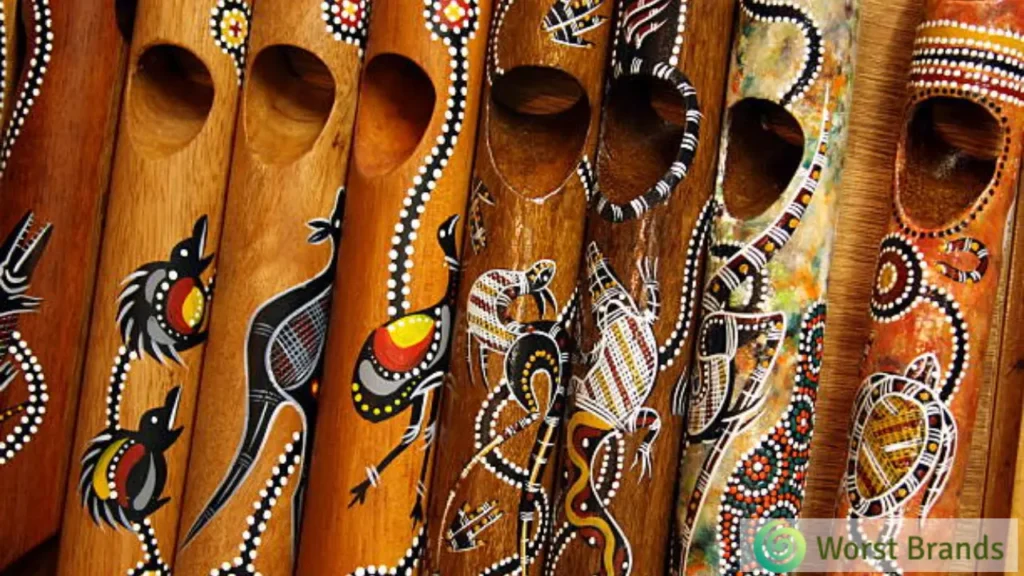When it comes to picking out the perfect didgeridoo, there’s more to consider than just its design.
Over the years, I’ve blown into quite a few of these incredible instruments, and, as with everything, there were a few brands that didn’t quite match up to the rest.
Now, don’t get me wrong, every didgeridoo brand has its own charm, but these 4 need serious improvements.
Based on personal experience and customer response, the worst didgeridoo brands to avoid include JIVE, Meinl, Terre, and World Rhythm.
Table of Contents
4 Worst Didgeridoo Brands
Now, let’s take a closer look at why these brands fall short in performance.

1. JIVE’s Spiral Shaped Didgeridoo
I’ve always been one to appreciate the finer things in music, especially unique instruments like didgeridoo.
That’s what drew me to the S-shaped Didgeridoo from the acclaimed JIVE brand.
On paper, this instrument seemed to tick all the boxes: it was handcrafted and made of solid mahogany, and the compact design seemed perfect for traveling musicians.
But let’s dive into the real experience. Its sound was off. Unlike the deep, resonant hum typical of didgeridoos, the sound emanating from this instrument was thin and faint, almost gasping for breath.
My initial attempts to play were hampered by the unusually restrictive aperture, making it a challenge to achieve that characteristic didgeridoo vibration.
When I closely inspected the instrument. Beneath its beautiful exterior, there were glaring issues: cracks that hinted at shoddy craftsmanship or maybe rough handling.
One of the more troubling finds was an area where it looked like the instrument had broken and was hastily glued back together.
These defects weren’t just cosmetic: they drastically affected the instrument’s sound quality.
To top it off, there was an overpowering varnish smell that made playing not just unenjoyable but also felt unsafe.
Although the aesthetics of the didgeridoo were unquestionably appealing, its functional performance was a stark contrast.
In essence, this S-shaped Didgeridoo from JIVE, while beautiful to behold, failed to deliver where it truly counted.
2. Meinl Trombone Didgeridoo
The Meinl Trombone Didgeridoo, with its innovative features, should have been a standout.
Yet, it reminded me of some mandolin brands that have great potential but fall short in delivery.
The sound was noticeably airy, lacking the rich resonance typical of traditional didgeridoos.
I’ve played simpler, more traditional didgeridoos in the past, and their tonal quality was significantly richer.
This trombone designed didgeridoo, despite being more expensive, required me to exert more effort for a lesser sound volume.
And the tone? It lacked the robustness that one might expect from a brand as renowned as Meinl.
For those looking for quality instruments, avoid this bad didgeridoo brand.

3. Didgeridoo Bamboo by Terre
Promising a modern flair, this brand, too, had its pitfalls.
While it’s crucial for any instrument to balance aesthetics with performance, this balance seemed missing here, much like some saxophones I’ve come across.
Crafted from bamboo and resin, with a standout key in ‘C,’ its description paints a picture of a finely tuned instrument. Yet, reality sometimes tells a different story.
While the allure lies in its aesthetic design, the structural integrity seems to be compromised.
Reports of significant cracks, even if not entirely through the instrument, highlight the potential for durability issues.
Such concerns are only magnified when users are prompted to overlook these flaws in favor of replacements, raising questions about consistent product quality.
Furthermore, functionality matters. Instances of the instrument making abrupt noises, or worse, coming apart, can be unsettling.
After all, the primary goal of any musical instrument is its sound, and any compromise on this front diminishes its value.
4. World Rhythm Didgeridoo
World Rhythm Didgeridoo boasts a stunning hand-painted cosmic design. However, its beauty might be its only strength.
Constructed from plastic, it doesn’t offer the traditional sound quality many seek.
Users have reported issues with the mouthpiece’s shape, making it difficult to produce the desired resonance and causing discomfort during play.
Even more concerning is the paint’s tendency to flake off after minimal use, which could raise health concerns.
Despite its aesthetic appeal, this didgeridoo might be better suited as a decorative piece rather than a functional instrument.
If you are passionate about the didgeridoo’s sound, you might want to explore and skip this subpar didgeridoo.
Conclusion
While many brands promise premium experiences, as we’ve seen, not all deliver on that promise.
It’s disheartening when what seems like a masterpiece turns out to be one of the worst didgeridoo brands in terms of functionality. But your musical journey deserves the best.
Don’t be swayed by mere aesthetics; seek out brands that harmonize beauty with authentic, rich sounds.
The right didgeridoo will not only complement your decor but will also elevate your musical experience. Choose wisely!
Christopher Evans is a Mechanical Engineer and is a distinguished expert in tire and electronic appliance testing with over 15 years of experience. Holding certifications like Automotive Tire Service (TIA) and Certified Appliance Professional (CAP). He is also a member of the the American Society of Mechanical Engineers (ASME) and has significantly contributed to safety standards and testing protocols in both industries. Evans is a respected speaker and award recipient.
